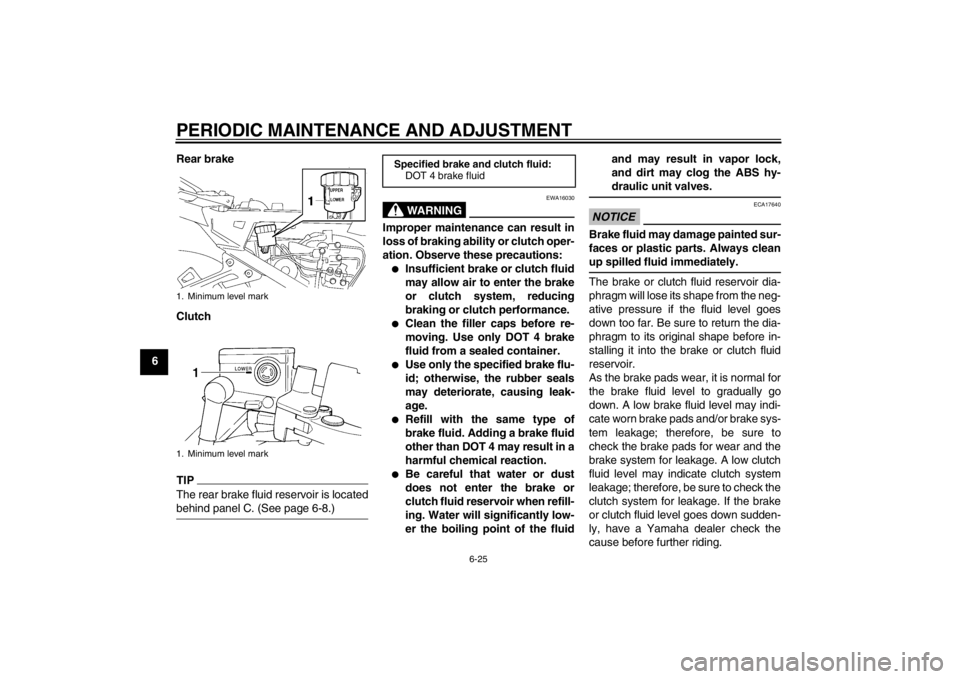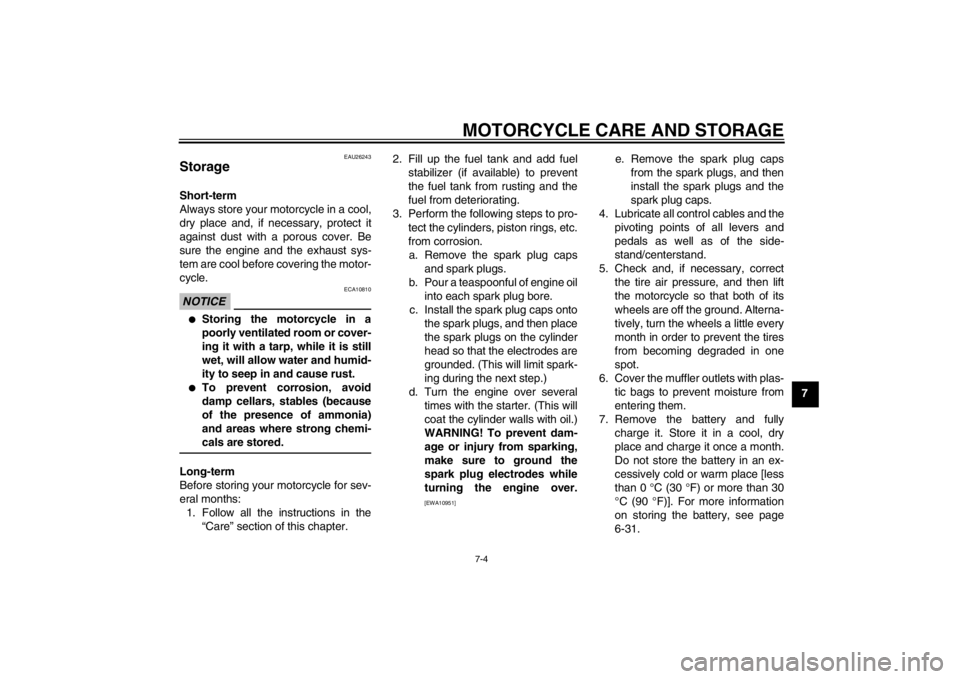Page 92 of 118

PERIODIC MAINTENANCE AND ADJUSTMENT
6-25
6Rear brake
Clutch
TIPThe rear brake fluid reservoir is located
behind panel C. (See page 6-8.)
WARNING
EWA16030
Improper maintenance can result in
loss of braking ability or clutch oper-
ation. Observe these precautions:●
Insufficient brake or clutch fluid
may allow air to enter the brake
or clutch system, reducing
braking or clutch performance.
●
Clean the filler caps before re-
moving. Use only DOT 4 brake
fluid from a sealed container.
●
Use only the specified brake flu-
id; otherwise, the rubber seals
may deteriorate, causing leak-
age.
●
Refill with the same type of
brake fluid. Adding a brake fluid
other than DOT 4 may result in a
harmful chemical reaction.
●
Be careful that water or dust
does not enter the brake or
clutch fluid reservoir when refill-
ing. Water will significantly low-
er the boiling point of the fluid and may result in vapor lock,
and dirt may clog the ABS hy-
draulic unit valves.
NOTICE
ECA17640
Brake fluid may damage painted sur-
faces or plastic parts. Always clean
up spilled fluid immediately.The brake or clutch fluid reservoir dia-
phragm will lose its shape from the neg-
ative pressure if the fluid level goes
down too far. Be sure to return the dia-
phragm to its original shape before in-
stalling it into the brake or clutch fluid
reservoir.
As the brake pads wear, it is normal for
the brake fluid level to gradually go
down. A low brake fluid level may indi-
cate worn brake pads and/or brake sys-
tem leakage; therefore, be sure to
check the brake pads for wear and the
brake system for leakage. A low clutch
fluid level may indicate clutch system
leakage; therefore, be sure to check the
clutch system for leakage. If the brake
or clutch fluid level goes down sudden-
ly, have a Yamaha dealer check the
cause before further riding.
1. Minimum level mark
1. Minimum level mark
Specified brake and clutch fluid:
DOT 4 brake fluid
U1MCE0E0.book Page 25 Thursday, July 19, 2012 6:59 PM
Page 109 of 118

MOTORCYCLE CARE AND STORAGE
7-4
7
EAU26243
Storage Short-term
Always store your motorcycle in a cool,
dry place and, if necessary, protect it
against dust with a porous cover. Be
sure the engine and the exhaust sys-
tem are cool before covering the motor-
cycle.NOTICE
ECA10810
●
Storing the motorcycle in a
poorly ventilated room or cover-
ing it with a tarp, while it is still
wet, will allow water and humid-
ity to seep in and cause rust.
●
To prevent corrosion, avoid
damp cellars, stables (because
of the presence of ammonia)
and areas where strong chemi-
cals are stored.
Long-term
Before storing your motorcycle for sev-
eral months:1. Follow all the instructions in the “Care” section of this chapter. 2. Fill up the fuel tank and add fuel
stabilizer (if available) to prevent
the fuel tank from rusting and the
fuel from deteriorating.
3. Perform the following steps to pro- tect the cylinders, piston rings, etc.
from corrosion.a. Remove the spark plug caps and spark plugs.
b. Pour a teaspoonful of engine oil into each spark plug bore.
c. Install the spark plug caps onto the spark plugs, and then place
the spark plugs on the cylinder
head so that the electrodes are
grounded. (This will limit spark-
ing during the next step.)
d. Turn the engine over several times with the starter. (This will
coat the cylinder walls with oil.)
WARNING! To prevent dam- age or injury from sparking,
make sure to ground the
spark plug electrodes while
turning the engine over.
[EWA10951]
e. Remove the spark plug caps from the spark plugs, and then
install the spark plugs and the
spark plug caps.
4. Lubricate all control cables and the pivoting points of all levers and
pedals as well as of the side-
stand/centerstand.
5. Check and, if necessary, correct the tire air pressure, and then lift
the motorcycle so that both of its
wheels are off the ground. Alterna-
tively, turn the wheels a little every
month in order to prevent the tires
from becoming degraded in one
spot.
6. Cover the muffler outlets with plas- tic bags to prevent moisture from
entering them.
7. Remove the battery and fully charge it. Store it in a cool, dry
place and charge it once a month.
Do not store the battery in an ex-
cessively cold or warm place [less
than 0 °C (30 °F) or more than 30
°C (90 °F)]. For more information
on storing the battery, see page
6-31.
U1MCE0E0.book Page 4 Thursday, July 19, 2012 6:59 PM
Page 112 of 118

SPECIFICATIONS
8-2
8
Secondary reduction ratio:2.698 (35/37 x 21/27 x 33/9)
Transmission type: Constant mesh 5-speed
Operation:
Left foot operation
Gear ratio: 1st:
2.529 (43/17)
2nd: 1.773 (39/22)
3rd: 1.348 (31/23)
4th:
1.077 (28/26)
5th: 0.929 (26/28)Chassis:Frame type:
Diamond
Caster angle: 26.00 °
Trail: 109 mm (4.3 in)Front tire:Type:Tubeless
Size: 120/70 ZR17M/C (58W)
Manufacturer/model:
BRIDGESTONE/BT023F F
Manufacturer/model: METZELER/Roadtec Z8
Rear tire:Type:Tubeless
Size:
180/55 ZR17M/C (73W)
Manufacturer/model: BRIDGESTONE/BT023R F
Manufacturer/model: METZELER/Roadtec Z8 CLoading:Maximum load:215 kg (474 lb)
(Total weight of rider, passenger, cargo and
accessories)Tire air pressure (measured on cold
tires):Loading condition:0–90 kg (0–198 lb)
Front:
250 kPa (2.50 kgf/cm², 36 psi)
Rear: 290 kPa (2.90 kgf/cm², 42 psi)
Loading condition: 90–215 kg (198–474 lb)
Front:
250 kPa (2.50 kgf/cm², 36 psi)
Rear: 290 kPa (2.90 kgf/cm², 42 psi)
High-speed riding: Front: 250 kPa (2.50 kgf/cm², 36 psi)
Rear: 290 kPa (2.90 kgf/cm², 42 psi)
Front wheel:Wheel type:Cast wheel
Rim size:
17M/C x MT3.50Rear wheel:Wheel type:Cast wheel
Rim size:
17M/C x MT5.50Unified brake system:Operation:Activated by rear brakeFront brake:Type:Dual disc brake
Operation: Right hand operation
Specified brake fluid:
DOT 4Rear brake:Type:Single disc brake
Operation:
Right foot operation
Specified brake fluid: DOT 4Front suspension:Type:
Telescopic fork
Spring/shock absorber type: Coil spring/oil damper
Wheel travel: 135.0 mm (5.31 in)
U1MCE0E0.book Page 2 Thursday, July 19, 2012 6:59 PM